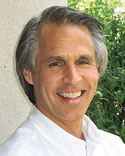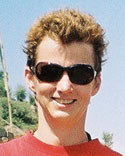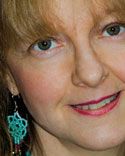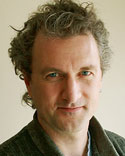 PAGAN KENNEDY, whose article “Man-Made Monk” is in this issue, tells us : “Three years ago, I learned that a British aristocrat named Laura Dillon, who become Michael Dillon in 1943, was the first to undergo a female-to-male sex change. After he’d refashioned his body, Michael Dillon fled the West for India, where he became one of the first Westerners to practice Buddhism according to Tibetan traditions. My book The First Man-Made Man (Bloomsbury) tells about Dillon’s adventures on the path to authenticity. ‘The conquest of the body proved relatively easy,’ Dillon observed at the end of this life. ‘But the conquest of the mind is a never-ending struggle.'”
PAGAN KENNEDY, whose article “Man-Made Monk” is in this issue, tells us : “Three years ago, I learned that a British aristocrat named Laura Dillon, who become Michael Dillon in 1943, was the first to undergo a female-to-male sex change. After he’d refashioned his body, Michael Dillon fled the West for India, where he became one of the first Westerners to practice Buddhism according to Tibetan traditions. My book The First Man-Made Man (Bloomsbury) tells about Dillon’s adventures on the path to authenticity. ‘The conquest of the body proved relatively easy,’ Dillon observed at the end of this life. ‘But the conquest of the mind is a never-ending struggle.'”
 PHILIP NOVAK was happy to reflect on the enduring global-interfaith importance of Thich Nhat Hanh’s Living Buddha, Living Christ roughly a decade after its publication. He writes: “It is hard to imagine a more beautiful heeding of Rumi’s advice to ‘love the pitcher less and the water more.’ In this book Nhat Hanh, one of the noblest and most profoundly influential Buddhists of our era, sees Buddhism and Christianity (and, by implication, other faiths) as complementary, cultural-symbolic systems for enabling human ethical maturity.”
PHILIP NOVAK was happy to reflect on the enduring global-interfaith importance of Thich Nhat Hanh’s Living Buddha, Living Christ roughly a decade after its publication. He writes: “It is hard to imagine a more beautiful heeding of Rumi’s advice to ‘love the pitcher less and the water more.’ In this book Nhat Hanh, one of the noblest and most profoundly influential Buddhists of our era, sees Buddhism and Christianity (and, by implication, other faiths) as complementary, cultural-symbolic systems for enabling human ethical maturity.”
 KATE WHEELER‘s essay on her retreat in a Himalayan cave appears in this issue (“Cave with a View”). “I wanted to write this in appreciation of the women who helped me so much,” she tells us, “and to set the record straight—it still blows me away how different it was to practice in a cave than I had expected. Years ago I was taught one of Milarepa’s songs in which he affirms that his supporters down in the valley will get every bit of his merit and eventually the same realization as he does. I have always known that my desire to run off to a cave was a little bit suspect—a coverup for impatience with other people and a desire to eliminate all my vulnerabilities. So I hope to clear that up: no matter where we go, we’re in relationship, even when we think we’re not!”
KATE WHEELER‘s essay on her retreat in a Himalayan cave appears in this issue (“Cave with a View”). “I wanted to write this in appreciation of the women who helped me so much,” she tells us, “and to set the record straight—it still blows me away how different it was to practice in a cave than I had expected. Years ago I was taught one of Milarepa’s songs in which he affirms that his supporters down in the valley will get every bit of his merit and eventually the same realization as he does. I have always known that my desire to run off to a cave was a little bit suspect—a coverup for impatience with other people and a desire to eliminate all my vulnerabilities. So I hope to clear that up: no matter where we go, we’re in relationship, even when we think we’re not!”  MIRANDA SHAW is the author of the cover story, “Mothers of Liberation.” She writes: “From the beginning of my personal and academic engagement with Vajrayana Buddhism, I sensed a gender imbalance in the presentation of the tradition. My own textual and historical research on Buddhist Tantra in India recovered an amazing heritage of female founders and women’s teachings that I presented in my first book, Passionate Enlightenment. I discovered a rich and diverse pantheon of goddesses that has been more integral to the tradition than we ever realized.”
MIRANDA SHAW is the author of the cover story, “Mothers of Liberation.” She writes: “From the beginning of my personal and academic engagement with Vajrayana Buddhism, I sensed a gender imbalance in the presentation of the tradition. My own textual and historical research on Buddhist Tantra in India recovered an amazing heritage of female founders and women’s teachings that I presented in my first book, Passionate Enlightenment. I discovered a rich and diverse pantheon of goddesses that has been more integral to the tradition than we ever realized.”
 BODHIPAKSA wrote this issue’s On Practice piece (“What You’re Made Of”). “The Six Element practice,” he writes, “is a neglected classic. Like Thich Nhat Hanh’s reflections on Interbeing, this practice cultivates a deep sense of connectedness with the world around us, including other people. And like insight meditation (Vipassana), it encourages us to observe the transitory nature of our experiences. It’s an incredibly rich and thorough practice that I’d love to see more people take up.”
BODHIPAKSA wrote this issue’s On Practice piece (“What You’re Made Of”). “The Six Element practice,” he writes, “is a neglected classic. Like Thich Nhat Hanh’s reflections on Interbeing, this practice cultivates a deep sense of connectedness with the world around us, including other people. And like insight meditation (Vipassana), it encourages us to observe the transitory nature of our experiences. It’s an incredibly rich and thorough practice that I’d love to see more people take up.”
Thank you for subscribing to Tricycle! As a nonprofit, we depend on readers like you to keep Buddhist teachings and practices widely available.